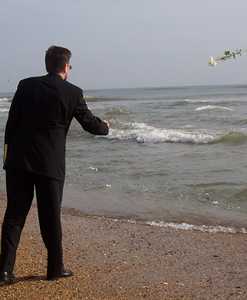WW II sailors
honored
BY SIBLEY FLEMING
AND JULIA LEDOUX, SENTINEL STAFF
 |
| Latvian minister Juris
Saivars tosses a daisy into the Atlantic Ocean
in memory of the crews of the Ciltvaira and her
seven sister ships. Photo By Julia
LeDoux/Sentinel Staff
| | Sixty-one years after the sinking of the
Ciltvaira, its crew is honored.
"Musu Tevs
debesis" ... Our Father in heaven ...
That was
the end of a ceremony honoring a story that began more
than 60 years ago.
Thursday on the beach in Nags
Head, Outer Banks Sentinel Managing Editor Sandy Semans
opened a wreath-laying ceremony honoring Latvian sailors
who worked with the Allies during War World II. There
were 45 people in attendance, including Latvian families
from both Dare County and New York, and several local
dignitaries.
"Most especially today, we salute
the eight Latvian vessels," said Semans, "the Everasma,
Abgara, Everalda, Regent, Everelza, Kegums, Everagra and
the Ciltvaira, which was torpedoed off Nags Head Jan.
19, 1942. Until this moment, the only recognition that
these vessels and crews have received is a single Nags
Head street named after the Ciltvaira."
Across
the ocean, the Chas daily newspaper in Riga, Latvia,
held a simultaneous wreath-laying ceremony at sea for
the same purpose. Suppressed for more than half a
century, the story of the sailors came to light several
months ago, when Latvian reporter Alex Krasnitsky began
digging.
Krasnitsky discovered that when Joseph
Stalin annexed Latvia at the beginning of WW II and
ordered the eight Latvian ships to return home, the
sailors refused to acknowledge Soviet authority. The
Ciltvaira was the first of six of the vessels to be
torpedoed by Germans and Italians. Of the eight, only
the Everagra and Ke'gums survived.
 |
At the ceremony, Nags Head Mayor
Pro Tem Mayor George Farah read a resolution adopted the
day before by that board that said, in part, "The Board
of Commissioners of the Town of Nags Head salutes the
country of Latvia and extends its sincere wish that the
bright light of freedom shall forever shine on Latvia
and all the world and that our nations shall live in
peace."
Farah noted that many ships met their
destiny off this stretch of North Carolina
coast.
"To the Latvian people, we have been proud
along this portion of the coast to be the keepers of the
Graveyard of the Atlantic," Farah said.
Other
remarks were given by Dare County Board of Commissioners
Chairman Warren Judge, who reviewed the area's place in
history as the site of the first English settlement in
the New World and as the birthplace of aviation nearly
100 years ago.
"It's these very shores that
you're standing on today that serve as an icon, an icon
for freedom and peace," he said.
Joseph
Schwarzer, director of the Graveyard of the Atlantic
Museum, noted that the crew of the ill-fated Ciltvaira
was international in its makeup. It comprised not only
Latvians, but also Estonians and a cabin boy from
British Guinea.
"These crew members did
something," he said. "In so doing, they lost their
homes, their families, and in some cases their
lives."
After the speeches, the U.S. Coast Guard
Group Cape Hatteras honor guard presented a 21-gun
salute to the eight vessels and their crews. Breaking
the silence that followed, a bagpiper played "Amazing
Grace."
Lt. jg. Jason Ingram of Coast Guard Group
Cape Hatteras saluted the maroon-and-white memorial
wreath.
A small Latvian national flag adorned the
wreath, which was carried out to sea by diver Bill
McDermott, owner of Outer Banks Dive Center.
On
shore, attendees tossed white daisies, the Latvian
national flower and a symbol of innocence and freedom,
into the waves.
The offering was followed by
remarks and a prayer by the Rev. Juris Saivars, a
Latvian Lutheran minister from New York. Saivairs said,
"Ladies and gentlemen, brothers and sisters, I am very
glad to be here today when we remember the events of 60
years past.
"The summer of 1942 was the time not
only of war but also of prayer.
"It was an
especially hard time for the Latvian Lutheran
Congregation of New York. This congregation was
organized by the Latvian seamen at the end of the 19th
century.
"At that time every Latvian in New York
had a friend or relative at sea.
"The captain,
Karlis Shkerbergs, was a member of New York Latvian
Church, too, and the end of his ship Ciltvaira made the
prayers especially tragic and poignant.
"During
the World War II, 110 members of the Latvian
Congregation were killed at sea.
"Still their
fate was envied by their friends in Latvia. These seamen
had a chance to fight and win and even to die for
freedom.
"People living in Latvia at that time
had no such chance because it was already divided
between two tyrannies-Nazi and Soviet.
"The
chance to fight for their freedom-that was the greatest
wish of all Latvians at all times.
"I am very
happy for one opportunity to say the Lord's Prayer today
for the Latvian freedom fighters in the same language in
which they prayed 60 years ago," said the
minister.
The lost story of the Latvian crew
erupted on the Outer Banks when Latvian reporter
Krasnitsky requested a photograph of the street E.
Ciltvaira from the Sentinel. The request was common-the
sharing of information or resources between two news
organizations.
"We supplied that," said Semans
who also asked, Why? "He explained he was trying to
reclaim a portion of their history and from there it
evolved."
Semans aided Krasnitsky by helping find
some fo the contacts that the Latvian reporter needed
for his research.
"Over the next couple of
months, the story evolved as a remarkable piece of work
on his part," said Semans.
The Sentinel editor
held the story until it could be published first in
Latvia, well aware that the story belonged to Krasnitsky
for whom Semans had come to have great professional
respect. As it evolved, however, both writers agreed
that some kind of recognition was in order for the eight
vessels and their crews.
"I think that we tend to
forget sometimes that as journalists we are writing
history every day and when we come up with a story that
has not been reported-whether it's 60 years old or 600
years, it's our duty to bring it to
light."
Latvia only regained its independence in
1991. The suppression of the story of the Latvian fleet,
said Semans, may have been a result of politics and not
wanting to offend other nations such as the Soviet
Union.
"I think that this isn't just a Latvian
story-it's American story. It's situations like this
that built America," she said.
Lativian-born
Manteo resident Katia Taylor McClure, adopted at 21
months of age and brought to live on the Outer Banks,
originally hails from Riga. The eight-year old attends
Manteo Elementary School.
Her mother, Pam
McClure, said she felt it was important to bring her
daughter out to the ceremony even though it meant
missing a little bit of school for Katia and a little
bit of work for her.
"It's a good thing to know
your heritage," Pam McClure explained, adding that
because of Katia's young age, it is difficult for her to
understand what Nazi, and later Soviet, occupation,
meant to her homeland.
Katia McClure had a broad
smile on her face as she threw a bunch of daisies into
the ocean in memory of men she never knew. And was Katia
excited to participate in the ceremony? She had a one
word answer for that
question:
"Yes."
|









